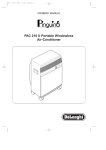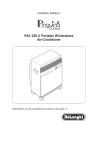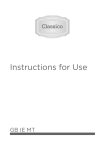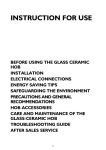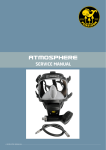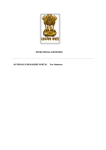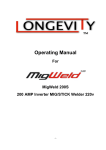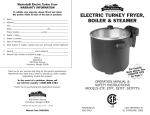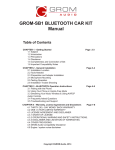Download Gorenje EC605ASC hob
Transcript
GB IE MT Instructions for use, mounting and connection Ceramic-glass Built-in Cooktop Ceramic-glass Built-in Cooktop Dear customer, Ceramic-glass built-in cooktop is made for domestic use only. Our products use environmentally friendly packaging, which can be either recycled or disposed of in an environmentally friendly manner. To this end, individual packaging materials are clearly marked. When your appliance finally wears out, please try not to burden the environment with it: call your nearest authorised service agent. Instructions for Use These instructions are intended for the user. They describe the cooker and how to use it. They also apply to different types of appliances, therefore you may find some descriptions of functions that may not apply to your appliance. Instructions for Installation This appliance should be connected to the power supply according to instructions for the connection of appliances in compliance with current standards and local regulations. The connection should be done by a qualified technician only. Rating Plate The rating plate with basic data is fixed on the rear wall of the appliance. Fire hazard protection Appliances are allowed to be mounted on one side next to a high kitchen cabinet, the height of which may exceed that of the appliance. On the opposite side however, only a kitchen cabinet of equal height as the appliance is allowed. 436550 Important - Read before using the appliance .............. 3 Glass Ceramic Cooktop ................................................. 5 Energy Saving Tips ........................................................ 6 Setting of Cooking Zones .............................................. 7 Cleaning and maintenance ............................................ 7 Mounting the Built-in Hob ............................................. 8 Electrical connections ................................................ 11 Connecting to Power Supply ...................................... 12 Type ............................................................................... 13 2 Important - Read before using the appliance Safety percautions • This appliance can be used by children aged from 8 years and above and persons with reduced physical, sensory or metal capabilities or lack of experience and knowledge if they have been given supervision or instruction concerning use of the appliance in a safe way and understand the hazards involved. Children shall not play with the appliance. Cleaning and user maintenance shall not be made by children without supervision. • WARNING: The appliance and its accessible parts become hot during use. Care should be taken to avoid touching heating elements. Children less than 8 years of age shall be kept away unless continuously supervised. • WARNING: Danger of fire: do not store items on the cooking surfaces. • WARNING: Unattended cooking on a hob with fat or oil can be dangerous and may result in fire. Never try to extinguish a fire with water, but switch off the appliance and then cover flame with a lid or a damp cloth. • After use, switch off the hob element by its control and not rely on the pan detector. • WARNING: If the surface is cracked, switch off the appliance to avoid the possibility of electric shock. • Do not use steam cleaners or high-pressure cleaners to clean the cooking hob, as this may result in an electric shock. • The appliance is not intended to be controlled by external timers or special control systems. • The appliance may only be connected to the power mains by an authorized service technician or expert. • Tampering with the appliance or non-professional repair thereof may result in risk of severe injury or damage to the product. Any repairs may only be carried out by an authorized service technician or expert. • The appliance is intended solely for cooking. Do not use it for any other purpose, e.g. for room heating. Do not place empty cookware on the cooking zones. • If another electrical appliance is connected to a AC power socket near the appliance, make sure the power cord does not come into contact with hot cooking zones. 3 436550 Warnings • Do not store temperature-sensitive items underneath the appliance, such as cleaners or detergents, spray cans etc. • Using the glass ceramic hob as a storage area may result in scratches or other damage to it. Never heat food in aluminium foil or in plastic containers on the cooking hob. Such foil or containers may melt which can result in a fire or damage to the cooking hob. The symbol on the product or on its packaging indicates that this product may not be treated as household waste. Instead it shall be handed over to the applicable collection point for the recycling of electrical and electronic equipment. By ensuring this product is disposed of correctly, you will help prevent potential negative consequences for the environment and human health, which could otherwise be caused by inappropriate waste handling of thisproduct. For more detailed information about recycling of this product, please contact your local city office, your household waste disposal service or the shop where you purchased the product. 436550 4 Glass Ceramic Cooktop 1. Cooking zone rear left 2. Cooking zone rear right 3. Control knobs 4. Cooking zone front right 5. Cooking zone front left The glass ceramic cooktop has four heating zones. Its surface is flat and there are no edges where food remains usually collect. • The heating zone reaches the preset temperature quickly, yet the area around the hot cooking zone remains cold. • The hob is resistant to temperature changes. • The ceramic hob is impact resistant. A dish can be placed on the hob a little harder and yet the surface will not be damaged. • Never use the ceramic hob as a working surface. Sharp objects may scratch it. • Preparation of food in aluminum or plastic dishes on hot cooking plates is not allowed. Do not place any plastic objects or aluminum foils upon the cooktop surface. • Do not prepare coffe in small traditional coffe pots if the diameter of the pot is smaller than the cooking area as it may result in damage. WARNING! 436550 • Never use a cracked or broken ceramic hob. The hob may break or crack if an object with sharp edges falls on it. The crack may be visible immediately or only after some time. Disconnect the appliance from mains immediately in case any cracks are detected upon the glass ceramic surface. • If you spill sugar or any other sweet substance, wipe the hob immediately, with cloth or use a scraper even when the cooking area is still hot. This will prevent damage to it. • Never use ordinary cleaning agents for cleaning the ceramic glass cooktop, as may damage the ceramic glass surface. 5 Pots and Pans Use only high quality pots with flat and stable bottom. • Always be careful to put the pot in the middle of the cooking zone. • If you use the pots made of temperature resistant glass or earthenware, always consider the manufacturer’s instructions. • If you use a pressure cooker, never leave it unattended. Select the highest temperature setting, wait until the correct pressure is reached in the pressure cooker and turn the knob to a lower setting, as recommended by the manufacturer of the pot. • When using high radiation (bright metal surface) crockery, or thick bottom dishes for preparing food on the glass ceramic hob, the period of reaching the boiling point may be prolonged for certain time (up to 10 minutes). Consequently, if you need to boil considerable amount of liquid, it is recommended to use the dark, flat bottom pot. The cooker top can be damaged if: • switched on and left uncovered or with an empty pot on it, • if you use pots with an inadequate bottom like uneven, rough or too small diameter bottoms (traditional coffee pan). • Never use the earthenware pots as they are very likely to scratch the ceramic glas surface. • Before putting the pot on the hot plate, thoroughly wipe the bottom of the pot, to prevent heat conduction and to protect the hot plate. Energy Saving Tips 436550 • The bottom of the pot should be slightly concave for optimum heat transfer from the cooking zone. • The bottom of the pot should always suit the size of the cooking zone. If the pot is smaller, it can cause energy loss and if larger, the cooking zone may become damaged. • Use a pot lid whenever possible. • The pot size should suit the quantity of food. Cooking smaller quantities of food in a large pot results in energy loss. • Food which needs longer cooking may also be prepared in the pressure cooker. • Various vegetables, potatoes, etc. can be cooked with a smaller quantity of water. This way the food is cooked much sooner, but do not forget to cover the pan properly. When the water starts boiling, turn the knob to the position for slow boiling. • Some 5-10 minutes before the food is cooked, switch off the hot plate , whichever you are using. 6 Setting of Cooking Zones The cooking zones are controlled by knobs mountedl on the control panel of the cooker. The heating degrees are marked on the knobs from 1 to 6, whereby position 1 is the lowest and position 6 respectively the highest setting. The heating is switched off in position 0. The intermidiate settings can also be selected and set in stages. The knob can be turned in both directions. Cleaning and maintenance Figure 1 Figure 2 Figure 3 After each use of the glass-ceramic hob, wait for it to cool down and clean it; otherwise, even the smallest food residue will be burnt onto the hot surface next time you use the appliance. For regular cleaning and maintenance of the glass-ceramic surface, use special conditioning agents which form a protective layer on the surface, shielding it from dirt. Before each use, wipe any dust or other particles from the hob surface and pan bottom as these could scratch the surface (Figure 1). Careful: steel wool, abrasive sponges, and abrasive detergents can scratch the hob surface. Glass ceramic surface can also be damaged by aggressive sprays and inappropriate or insufficiently shaken (mixed) liquid cleaning agents (Figure 1 and Figure 2). Signage may be worn when using aggressive or abrasive cleaners or cookware with damaged bottom (figure 2). Light stains can be removed by a damp soft cloth; then, wipe the surface dry (Figure 3). Water stains can be removed using a mild solution of vinegar; however, do not use this solution to clean the frame (only with some models, as it may become dull. Do not use aggressive sprays or decalcification agents (Figure 3). Heavier stains can be removed using special agents and utensils for cleaning the glass-ceramic hobs. When using these products, follow the instructions provided by their respective manufacturers. Make sure any residues of cleaning agents are thoroughly removed, as they could damage the glass-ceramic hob when the cooking zones heat up (Figure 3). Remove stubborn and burnt residues with a scraper (figure 4). Be careful when handling the scraper to prevent injury. Only use the scraper when dirt cannot be removed with a wet cloth or special cleaners for glass ceramic surfaces. 7 436550 Cleaning Hold the scraper at the correct angle (45° to 60°). Gently press the scraper against the glass and slide it over the signage to remove the dirt. Make sure the plastic handle of the scraper (in some models) does not come into contact with a hot cooking zone. Figure 4 Figure 5 Do not press the scraper perpendicularly against the glass and do not scratch the hob surface with its tip or blade. Sugar and sugar-laden food may permanently damage the glassceramic surface (Figure 5); therefore, they should be removed from the glass-ceramic surface as soon as possible, although the cooking zone may still be hot (Figure 4). Any change in the color of the glass-ceramic surface does not affect its operation or the stability of the surface. Such discolorations are mostly a result of burnt food residues or use of cookware made of materials such as aluminum or copper; these stains are difficult to remove. Warning: All damage described above predominantly relates to the aesthetics, i.e. appearance of the appliance and do not affect its functionality directly. Such errors cannot be the subject of a warranty claim. Mounting the Built-in Hob • The plywood coating of the kitchen elements should be processed with temperature resistant adhesives (100°C), otherwise they may distort or change shape. • The use of decorative trimmings made of solid wood on the worktop behind the cooking zone is allowed only in case the minimum distance is as marked on the drawings for mounting. • Cut out the top panel of the kitchen unit into which the ceramic glass cooktop is to be built into. • Minimum distance between the built-in cooktop and the rear wall is marked on the installation drawing. • Protect the edges of the openings, if necessary. • Built-in cooktop may be mounted into 30 - 40 mm thick working tops. • In case there is a drawer in kitchen cabinet under the built-in hob, it is necessary to install an additional horizontal barrier of height 6 cm under the hob and above the drawer. 436550 8 Installing the foam gasket Before inserting the appliance into the opening in the kitchen worktop, the supplied foam gasket must be attached to the lower side of the glass ceramic (glass) cooking hob (see figure above). Do not install the appliance without the foam gasket! The gasket should be attached to the appliance in the following way: - Remove the protective film from the gasket. - Then, attach the gasket to the lower side of the glass, approximately 2-3 millimetres from the edge (as shown in the figure). The gasket must be attached along the entire length of the glass edge and should not overlap at the corners. - When installing the gasket, make sure that the glass does not come into contact with any sharp objects. NOTE! On some appliances the gasket is already installed! Mounting dimensions 436550 600 595- 9 • Worktop should be perfectly levelled. • Respect the instructions shown in Fig. 1 regarding installation. • Protect the cut edges and openings and insert adequate packing. • Insert the appliance into the opening. • Push firmly the cooktop plate from above and fix it with four (4) screws from below. Watch the position of mounting braces: they may differ for 30 mm and 40 mm worktops (Fig. 2 and 2a). • For screwing down the fixing clip it is not allowed to use screws longer than 6,5 mm. 1 worktop 2 built-in cooktop 3 kitchen unit 4 screw 5 metal brace 436550 10 Electrical connections 436550 • The electric built-in cooker has to be mounted and installed by a qualified technician. The protection of the electrical wiring shall comply with current standards and regulations. • Before connecting the appliance to the power source, make sure that the voltage stated on the rating plate complies with the voltage of your power supply. • The rating plate of the ceramic glass hob is fixed on the lower side of the hob. • The cooker shall be connected to 230 V AC. • Electric connections shall be of such design, to incorporate a protection device between the appliance and the supply, like fuses or FI switches (to assure at least a 3 mm clearance between the contacts in open position). • The connection should be made considering the current capacity of the installation and the fuses. • Fire protection is of class Y, which means that the appliance may be mounted between two kitchen units; one of them may be higher than the appliance itself, the other has to be of the same height. • After mounting, the live parts and insulated parts of the appliance should be protected against accidental contacts. • The distance between the ceramic glass hob and the hood should be at least as stated in the instructions for mounting the hood. • No kitchen furniture drawers are allowed to be mounted below the glass ceramic cooktop. 11 Connecting to Power Supply Power supply may be connected by the qualified technician only. Connecting sockets are available when you open the connecting box cover. WARNING! Before repairing or servicing, disconnect the power supply. According to the mains voltage the appliance should be connected in line with the displayed diagram. Protective conductor (PE) should be connected to the socket marked EARTH . Connecting cable should be inserted through the clamp device to prevent eventual pullout. Upon completed power connection switch all hotplates for about 3 minutes to check they function properly. Connecting diagram A B NOTE: In some connection boxes the connector bridges are placed between contacts 4 and 5, and in the others they are stored at a designated place within the box. These boxes have the connection screws already in open position so they need not be unscrewed. During the tightening procedure you will hear a faint “click”, meaning that the tightening screw should be fastened tightly all the way. Following cables may be used for connection: - rubber connecting cables type H05 RR-F 4X1,5 with yellow-green protection conductor; - PVC insulated connection cables type H05 VV-F 4x1,5 with yellow-green protection conductor or - any other suitable cable of equal or better properties. 436550 12 Type Type SVK667S Mains voltage 2N AC 400 V Operating voltage 230 V, 50 Hz Type of control knobs S=gradual increase Cooking zones (ø mm/kW) S =standard plate Total power (kW) 210/2,1/S 145/1,2/S 180/1,7/S 145/1,2/S 6,2 WE RESERVE THE RIGHT TO MAKE ANY CHANGES THAT DO NOT AFFECT THE FUNCTIONALITY OF THE APPLIANCE. Instructions for use of the appliance can also be found on our website at www.gorenje.com / < http://www.gorenje.com /> 13 436550 Front left Rear left Rear right Front right 436550 14 SVK 667S en (04-14)
















